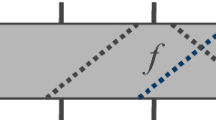Abstract
A model called global cellular automata (GCA) will be introduced. The new model preserves the good features of the cellular automata but overcomes its restrictions. In the GCA the cell state consists of a data field and additional pointers. Via these pointers, each cell has read access to any other cell in the cell field, and the pointers may be changed from generation to generation. Compared to the cellular automata the neighbourhood is dynamic and differs from cell to cell. For many applications parallel algorithms can be found straight forward and can directly be mapped on this model. As the model is also massive parallel in a simple way, it can efficiently be supported by hardware.
Access this chapter
Tax calculation will be finalised at checkout
Purchases are for personal use only
Preview
Unable to display preview. Download preview PDF.
Similar content being viewed by others
References
S. Achasova, O. Bandman, V. Markova, and S. Piskunov. Parallel Substitution Algorithm. World Scientific, P O BOX 128, Farrer Road, Singapore 9128, 1994.
Christian Hochberger, Rolf Hoffmann, and Stefan Waldschmidt. Compilation of CDL for different target architecures. In Viktor Malyshkin, editor, Parallel Computing Technologies, pages 169–179, Berlin, Heidelberg, 1995. Springer.
Rolf Hoffmann, Bernd Ulmann, Klaus-Peter Völkmann, and Stefan Waldschmidt. A stream processor architecture based on the configurabel CEPRA-S. In Reiner W. Hartenstein and Herbert Grünbacher, editors, Field-Programmable Logic and Applications, pages 822–825, Berlin, Heidelberg, 2000. Springer.
A.N. Kolmogorov and V.A. Uspenskii. On the definition of an algorithm. In American Mathematical Society Translations, volume 9 of Series 2, pages 217–245. American Mathematical Society, 1963.
Arnold Schönhage. Real-time simulation of multidimensional turing machines by storage modification machines. SIAM Journal on Computing, 9(3):490–508, August 1980.
Samuel D. Stearns. Digital Signal Analysis. Hayden Book Company, Rochelle Park, New Jersey, 1975.
T. Toffoli and N. Margolus. Cellular Automata Machines. MIT Press, Cambridge Mass., 1987.
Author information
Authors and Affiliations
Editor information
Editors and Affiliations
Rights and permissions
Copyright information
© 2001 Springer-Verlag Berlin Heidelberg
About this paper
Cite this paper
Hoffmann, R., Völkmann, KP., Waldschmidt, S., Heenes, W. (2001). GCA: Global Cellular Automata. A Flexible Parallel Model. In: Malyshkin, V. (eds) Parallel Computing Technologies. PaCT 2001. Lecture Notes in Computer Science, vol 2127. Springer, Berlin, Heidelberg. https://doi.org/10.1007/3-540-44743-1_6
Download citation
DOI: https://doi.org/10.1007/3-540-44743-1_6
Published:
Publisher Name: Springer, Berlin, Heidelberg
Print ISBN: 978-3-540-42522-9
Online ISBN: 978-3-540-44743-6
eBook Packages: Springer Book Archive




